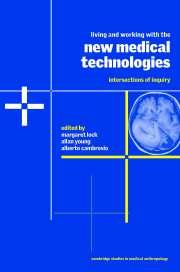1 - Introduction
Published online by Cambridge University Press: 23 December 2009
Summary
Use of the term “intersections” in the title of this book undoubtedly evokes impressions of postmodernist rhetoric, yet it is also a term long used by symbolic interactionist sociologists to analyze “intersecting” lines of action and social worlds. This interplay of postmodernity and tradition is precisely one of the “intersections” we undertake to explore in this volume. Further intersections arise between the various analytical approaches exemplified by the authors represented in this book, and also between the human actors, the tools, the entities and the bodies that are constitutive of the new medical technologies. How these intersections relate to each other, in other words, how new biomedical objects and subjects call for new kinds of analyses, is one of the issues raised by the present collection of articles.
As indicated by the book's title, one can work with the new medical technologies, and we all live, directly or indirectly, with them. Some of the contributors tend to focus on the “working” side of this equation, others on its “living” side, while all struggle, more or less openly, to bring these two sides together. The authors display many differences in their choice of topics and approach (two not entirely independent elements). However, they share an understanding of “body politics” that, instead of rejecting or accepting recurring dichotomies such as that between Nature and Culture, looks at how dichotomies are produced. Yet, rather than focusing on either differences or commonalities, it seems more interesting to us to look at intersections, that is, temporary convergences that can lead to advances on some particular problem, with no pretence of providing a comprehensive world-view or a theoretical manifesto.
- Type
- Chapter
- Information
- Living and Working with the New Medical TechnologiesIntersections of Inquiry, pp. 1 - 16Publisher: Cambridge University PressPrint publication year: 2000
- 5
- Cited by



